SMS Hansa was an ironclad corvette built in 1868–1875, and first ironclad built in Germany. She was named after the Hanseatic League, laid down in 1868 as a corvette, modified and launched in October 1872 as an ironclad, commissioned into the Kaiserliche Marine in May 1875. She was not at first a high seas ship but was tailored for coastal bombardment, armed with eight 21 cm (8.3 in) guns in a central battery. She took part in fleet exercises in the 1875 training year, made a major overseas cruise to Central and South America until 1880, protected German nationals during the Pacific war. In 1884, her iron hull was found badly corroded, so she was removed from active duty and used as auxiliary, a guard ship in Kiel, machinery crew trainer, but she was in such poor condition by 1888 as to be stricken, demoted as barracks ship in Kiel, then Mönkeberg in 1905, training personnel until 1906 and sold for BU. Not a brilliant career but she at least gave Kaiserliche Werft, Danzig a first taste of ironclad construction. #kaiserlichesmarine #germannavy #hansa #hanseaticleague #ironclad #corvette
Development
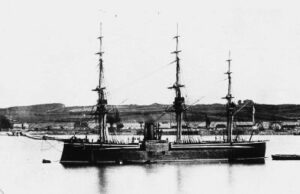 Development of a small armored corvette started in 1861, after first ironclads entered service in France abd UK. The Prussian naval staff initially envisioned consider purchasing a few small armored vessel to destroyer enemy coastal fortifications, inspired by French floating batteries at Kinburn in 1855. Work proceeded slowly, and the Prussian authorities realized that no shipyard was able to proceed to a construction at home, so to built experience, it was decided to purchase as series of ironclads from British and French shipyards. The design evolved and so when the new design was ready in 1867, all agreed on a casemate ship like HMS Pallas made by Edward Reed.
Development of a small armored corvette started in 1861, after first ironclads entered service in France abd UK. The Prussian naval staff initially envisioned consider purchasing a few small armored vessel to destroyer enemy coastal fortifications, inspired by French floating batteries at Kinburn in 1855. Work proceeded slowly, and the Prussian authorities realized that no shipyard was able to proceed to a construction at home, so to built experience, it was decided to purchase as series of ironclads from British and French shipyards. The design evolved and so when the new design was ready in 1867, all agreed on a casemate ship like HMS Pallas made by Edward Reed.
The design was for a “corvette” (likely a Frigate for others) built from wood but fitted with a 114 mm thick armor cast by Krupp (wrought iron). Plan were based on purchased British designs and it’s possible that British advisors were present when her keel was laid down at Kaiserliche Werft, Danzig at the time, not the Prussian Navy but the North German Confederation. The christening speech was done on October 26, 1872 by deputy commanding general of the IX Army Corps in Hamburg-Altona, Lieutenant General Hermann von Tresckow and the bottle broken by his daughter. On August 19, 1873, the hull was towed to Stettin to be completed at the Vulcan shipyard in December 1874.
She arrived at Kiel on January 3, 1875, in which remaining work was carried out in the floating dock and she was celebrated in the press at the time, as the first ironclad built in Germany. The first steel ironclad ship built in Germany later became the armored corvette SMS Oldenburg. Her cost has 3.665.000 Mark.
Design of the class
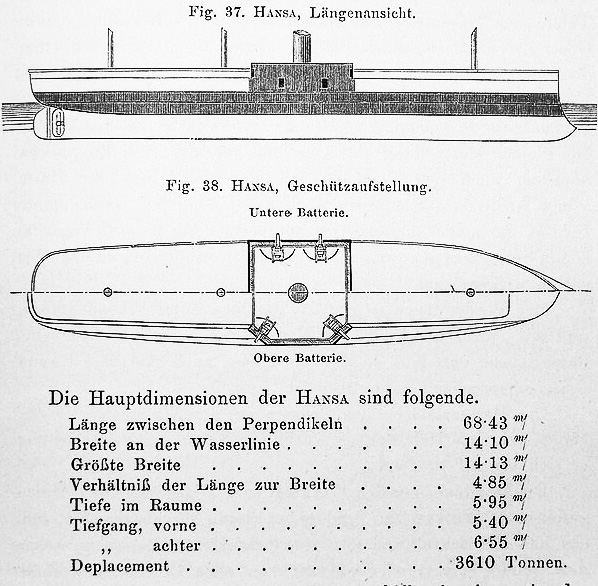
Hull and general design
SMS Hansa measured 71.73 meters (235.3 ft) long at the waterline, 73.50 m (241.1 ft) overall with her bowsprit. Her beam was 14.10 m (46.3 ft) and draft of 5.74 m (18.8 ft) forward, 6.80 m (22.3 ft) aft. Her designed displacement was 3,950 metric tons (3,890 long tons; 4,350 short tons) normal load, but 4,404 t (4,334 long tons; 4,855 short tons) fully loaded. She was a mixed vessels, with timber all around but transverses iron frames. The underwater hull was plated with copper to stop fouling as customary since centuries. The hull was also subdivided intosix watertight compartments.
Her crew amounted to 28 officers and 371 enlisted men and she carried smaller boats aboard, with two launches, one pinnace, two cutters, one yawl, one dinghy. She could also load picket boats and barges to land parties.
Powerplant
SMS Hansa as usual for the time was given a single three-bladed screw prpoeller that was 6 m (20 ft) in diameter, connected via its shaft to a single horizontal three-cylinder single-expansion steam engine, built by AG Vulcan, Stettin. Steam came at a pressure of at 2 standard atmospheres (200 kPa) from four trunk boilers located in the same boiler room. They were ducted into a single large funnel. The novelty was that the latter could be retracted when under sail, cleared off the way. This machinery was rated at 450 nominal horsepower. Top speed was 12 knots (22 km/h; 14 mph) and on trials, with this propulsion system she managed to reach 3,275 indicated horsepower (2,442 kW), and 12.7 knots (23.5 km/h; 14.6 mph).
For range, she carried 310 t (310 long tons; 340 short tons) of coal, translated into 1,330 nautical miles (2,460 km; 1,530 mi), at a cruising speed of 10 knots (19 km/h; 12 mph). Of course from the start she ws to be equipped with a full sailing rig, on three masts and a bowsprit, for a total sail area of 1,760 m2 (18,900 sq ft). The German navy her however very stiff for sea-keeping, but steering was just sufficient as she was controlled by a single, but large rudder. She was found very maneuverable overall, and particular attenton has bedn paid for her performances under sail as well. Under steam she remained highly maneuverable but control was less impressive.
Armament
Main
Hansa had main battery of eight 21 cm RK L/19 hooped guns, 20.95-centimeter (8.25 in) in caliber, each provisioned with 110 rounds of ammunition. They were placed in a two stage arrangement amidships in the central citadel, four mounted in a broadside casemate, two on either side to cover all angles, and the other four guns were mounted in casemates on the corners of the lower casemate. They had limited tracerse on rails but could depress to −5° and elevate to 13°, which in the latter case, gave them a 3,200 m (3,500 yd) range. The upper guns could elevate a bit more, to 14° for a range of 5,700 m (6,200 yd). That was it. No secondary guns.
Protection
Hansa was given a wooden hull which belt was made in teak, with an external cover of wrought iron, manufactured in Great Britain. This armored belt reached 152 mm (6 in) amidships. On the bow and stern, it was tapered down to 114 mm (4.5 in), but backed by 306 mm (12 in) of timber. This was customary at the time to bring some flexibility to an otherwide rigid and brittle iron plating. Casemates were also armored by 114 mm thick, in sloping plates. The lower battery was also 114 mm thick, with transverse armored bulkheads closing this citadel. Anti-torpedo nets were briefly installed from 1885 to 1888, but her role was already much reduced.
⚙ specifications |
|
| Displacement | Design: 3,950 t (3,890 long tons) Full load: 4,404 t (4,334 long tons) |
| Dimensions | 73.50 x 14.10 x 5.74m (241.1 ft, 46.3 ft, 18.8 ft) |
| Propulsion | 1 shaft single-expansion steam engine, 4 × boilers 450 nhp |
| Speed | 12 knots (22 km/h; 14 mph) |
| Range | 1,330 nmi (2,460 km; 1,530 mi) at 10 knots (19 km/h; 12 mph) |
| Armament | 8 x 21 cm (8.3 in) L/19 guns |
| Protection | 114 to 152 mm (4.5 to 6.0 in), Battery: 114 mm (4.5 in) |
| Crew | 28 officers + 371 enlisted men |
Construction and initial service
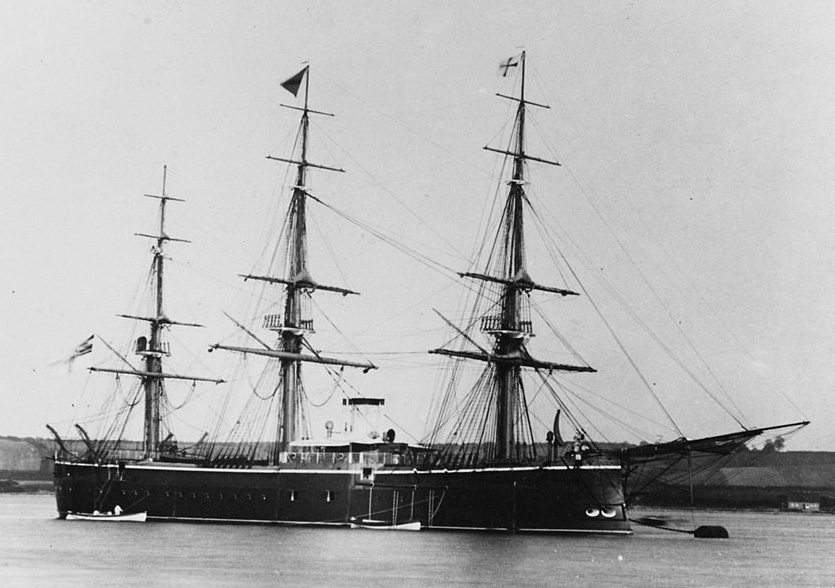
SMS Hansa was laid down at Königliche Werft (Royal Dockyard) as een above, in Danzig, on 16 November 1868. As the first ironclad warship be built in a German shipyard she had still a wooden hull but was completed using British wrought iron plates. Work on was slowed down due to two factors:
-The long process to properly dry the wood used for her hull
-The inexperience of the shipyards with ironclad warships.
-The Franco-Prussian War of 1870–1871 and full mobilization.
She was launched on 26 October 1872 with a speech of General Hermann von Tresckow (commander of IX Corps), first such speech given at a launch ceremony for a Prussian or German warship. Many more would follow. She was towed to the AG Vulcan shipyard, Stettin for fitting out, starting on 19 August 1873 and completed in December 1874 before she was towed to Swinemünde.
Career of SMS Hansa
From there, she was to sail to Kiel under Kapitän zur See (KzS—Captain at Sea) Adolph Berger, director of the naval artillery depot in Kiel before her commission. On 16 December, while off Swinemünde, she ran aground and returned to port for inspection. She was escorted by the transport ship SS Eider when sailing off 31 December. After she arrived in Kiel on 3 January 1875, she went into a floating dry dock for her final fitting-out from 24 February until full commission on 19 May, so two and a half years after launch.
At the time she only saw service in the summer months and by the winter, placed in reserve or reduced commission as guard ship an this summer 1875 on June, she trained with the 3rd Squadron with the ironclads Kronprinz, König Wilhelm, and Kaiser. They cruised to Rügen by July escoting Crown Prince Frederick. Back in Dantzig bay, she took part in training exercises and was also visited by Stosch. Sje took part in a naval review for Kaiser Wilhelm I on 22–23 September but the training Squadron was disbanded and she was decommissioned on 4 November.
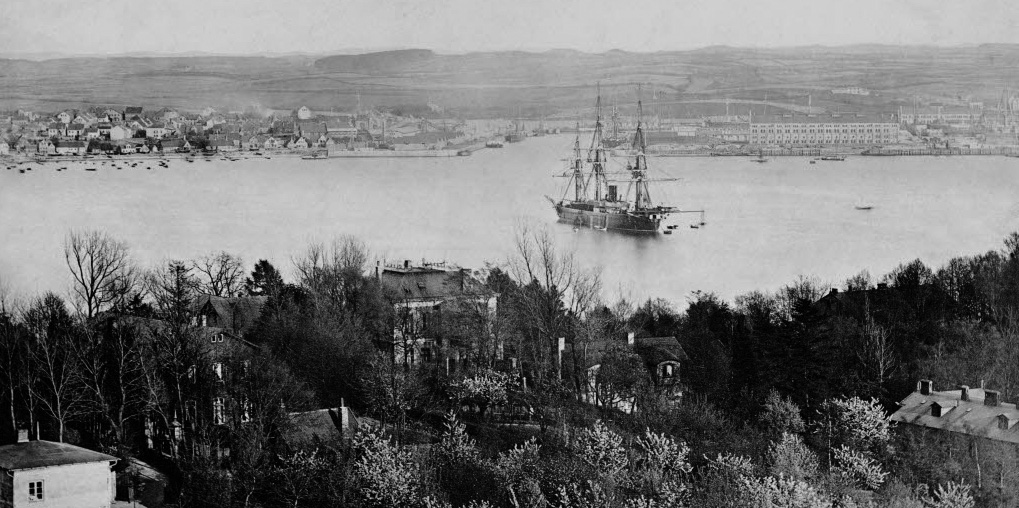
Recommissioned on 22 July 1878, she was redeployed in the West Indies and when recommissioned she was placed under command of Korvettenkapitän Karl Eduard Heusner. She was placed in the first category of reserve on 21 August and repared for a trip on 1 October, departing Kiel on 31 October up to Charlotte Amalie, Danish West Indies on 3 January 1879. She theh sailed to Venezuela, as unrest threatened Europeans, she met the German steam corvette Nymphe in La Guaira and they sent landing parties to protect German nationals in Puerto Cabello as well as US citizens in La Guaira. Her engines developed troubles and she narrowly escaped colliding with other in harbor thanks to her crew’s management of her sails. She only left on 20 February.
Next she was in Curaçao, Lesser (Dutch) Antilles, until late March and then toured ports in the Greater Antilles, visiting Greytown in Nicaragua, Colón in Colombia, Saint Thomas (Danish West Indies),and from there proceeded to the east coast, Bahia (22-30 June) until ordered to transition to the west coast as the Pacific War between Peru, Chile, and Bolivia broke out, so again she had to protect nationals. From Montevideo, she arroved in Valparaiso on 19 August, then to Callao, Peru as the Peruvian government just seized the German steamer SS Luxor allegely for “contraband” and seizure through a prize court. Hansa received the steamer’s crew but could not secure the vessel’s release. On 8 September she left under strict orders to remain neutral, but she was soon reinforced by the steam corvette Freya and the gunboat Hyäne.
After the Chilean victory in the Battle of Angamos (8 October) the Chilean Navy planned to bombard Callao, an open city, and the German governor Heusner protested it, the Chilean government eventually cancelling it with Hansa backing this off by cruising off the Peruvian and Chilean coasts until June 1880 but repeatedly sent landing parties in Callao, Lima, and Arica. Hyäne was in Valparaiso on 1 February 1880, Freya joined both on 3 March. Hyäne was recalled on 3 April, then Freya on 14 April as the war was soon over. The steam corvette Bismarck arrived on 26 May when Chile defeated Bolivia at Tacna, ending the war. Bismarck stayed with Hansa until July, and proceeded by mid-August with the corvette Ariadne in Coronel (Chile) for an exchange of posting on 11 August. Hansa left for home and was in Kiel on 22 October, decommissioned on 8 November.
Later career
After being decommissioned, she saw an overhaul to stay active until February 1884. She was to be sent in the eastern Mediterranean (Anglo-Egyptian War) but this was cancelled. From 22 February she becale a guard ship in Kiel, a training ship for boiler/engine room crews. She only made several short training cruises and on 28–29 June, she carried Prince Wilhelm and Prince Heinrich (grandsons) for a cruise with the Ironclad Training Squadron. On 10 August, she resumed short training cruises and by 14 October, assisted the corvette Gneisenau, running aground off Lolland. KzS Conrad Dietert became her new captain and she took part in fleet’s training activities, Baltic and North Seas. She also made a short tour with the ironclad Friedrich Carl and Bayern and in 1886, ended in the II Division leading four screw corvettes. She joined the Ironclad Squadron on 7 June 1887 for the Kaiser Wilhelm Canal’s ceremonies followed by firing practice and training cruises.
By early 1888, her hull was inspected, showing it was badly corroded so she was formally stricken on 6 August 1888, and still deteriorated until declared unseaworthy. She was converted as a floating barracks assigned to the II. Torpedo Division, Kiel, but received central heating and electrical lighting, until 1905. She was towed to Mönkeberg and hulked, still training boiler stokers and sold in March 1906 (for 96,000 marks) BU in Swinemünde.
Read More/Src
Books
Dodson, Aidan (2016). The Kaiser’s Battlefleet: German Capital Ships 1871–1918. Seaforth Publishing.
Gröner, Erich (1990). German Warships: 1815–1945. Vol. I: Major Surface Vessels.
Hildebrand, Hans H.; Röhr, Albert & Steinmetz, Hans-Otto (1993). Die Deutschen Kriegsschiffe.
Lyon, Hugh (1979). “Germany”. In Gardiner, Robert; Chesneau, Roger; Kolesnik, Eugene M. (eds.). Conway’s All the World’s Fighting Ships 1860–1905.
Sondhaus, Lawrence (1997). Preparing for Weltpolitik: German Sea Power Before the Tirpitz Era.
Sondhaus, Lawrence (2001). Naval Warfare, 1815–1914. London: Routledge.
Ottomar Fecht: Die Kaiserliche Marine 1871/80 in iberoamerikanischen Gewässern. Marine-Rundschau.
Erich Gröner, Dieter Jung, Martin Maass: Die deutschen Kriegsschiffe 1815–1945. Vol 1.
Stichwort: Panzerkorvette Hansa. Hans H. Hildebrand, Albert Röhr, Hans-Otto Steinmetz
Einbändiger Nachdruck der siebenbändigen Originalausgabe. Vol.3 Mundus, Ratingen 1983
ünter Kroschel, August-Ludwig Evers (Hrsg.): Die deutsche Flotte 1848-1945, Wilhelmshaven 1963.
Otto J. Seiler: Südamerikafahrt. Deutsche Linienschiffahrt nach den Ländern Lateinamerikas, der Karibik und der Westküste Nordamerikas im Wandel der Zeiten.
The Blockade of Callao. A Chilian fleet preparing to bombard the city. The New York Times. 6. May 1880.
Erwähnung der ersten Freilassung der Luxor in dem Artikel: Peru and Chili in arms. The war in South America. The New York Times. 3. July 1879
Gerhard Wiechmann: Die Königlich Preußische Marine in Lateinamerika 1851 bis 1867. Sandra Carreras, Günther Maihold.
Hans-G. Hilscher, Dietrich Bleihöfer: Hansastraße. In: Kieler Straßenlexikon. Fortgeführt seit 2005. Kiel Feb. 2017
Links
dreadnoughtproject.org S.M.S._Hansa (1872)
dbpedia.org/ SMS_Hansa_(1872)
deutsche-schutzgebiete.de/ s-m-s-hansa-1872/
de.wikipedia.org Hansa_(Schiff,_1875)
en.wikipedia.org/ SMS_Hansa_(1872)
Model Kits
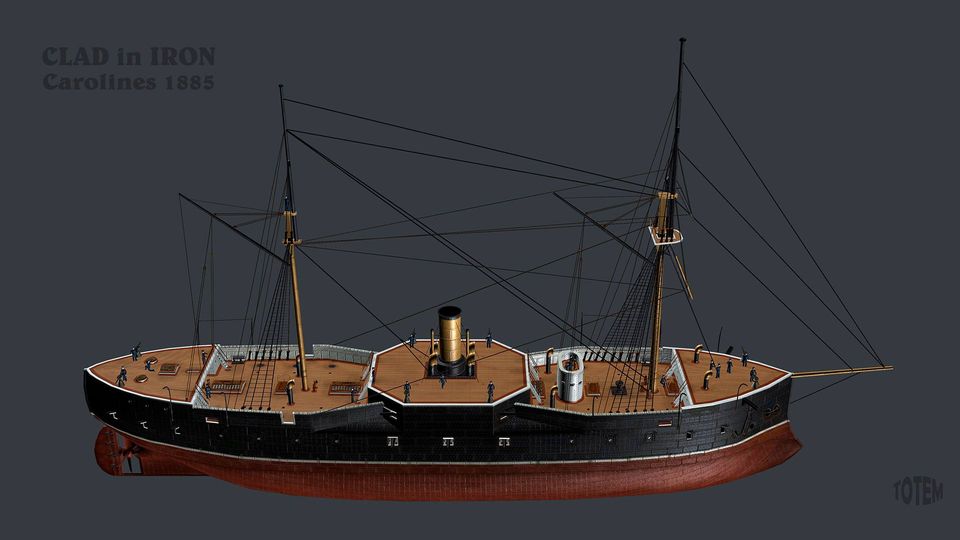
A nice 3D rendition (from facebook)

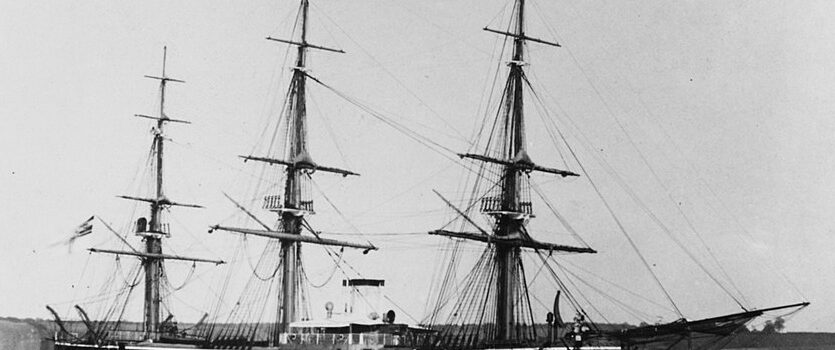

 Latest Facebook Entry -
Latest Facebook Entry -  X(Tweeter) Naval Encyclopedia's deck archive
X(Tweeter) Naval Encyclopedia's deck archive Instagram (@navalencyc)
Instagram (@navalencyc)





 French Navy
French Navy Royal Navy
Royal Navy Russian Navy
Russian Navy Armada Espanola
Armada Espanola Austrian Navy
Austrian Navy K.u.K. Kriegsmarine
K.u.K. Kriegsmarine Dansk Marine
Dansk Marine Nautiko Hellenon
Nautiko Hellenon Koninklije Marine 1870
Koninklije Marine 1870 Marinha do Brasil
Marinha do Brasil Osmanlı Donanması
Osmanlı Donanması Marina Do Peru
Marina Do Peru Marinha do Portugal
Marinha do Portugal Regia Marina 1870
Regia Marina 1870 Nihhon Kaigun 1870
Nihhon Kaigun 1870 Preußische Marine 1870
Preußische Marine 1870 Russkiy Flot 1870
Russkiy Flot 1870 Svenska marinen
Svenska marinen Søværnet
Søværnet Union Navy
Union Navy Confederate Navy
Confederate Navy Armada de Argentina
Armada de Argentina Imperial Chinese Navy
Imperial Chinese Navy Marinha do Portugal
Marinha do Portugal Mexico
Mexico Kaiserliche Marine
Kaiserliche Marine 1898 US Navy
1898 US Navy Sovietskiy Flot
Sovietskiy Flot Royal Canadian Navy
Royal Canadian Navy Royal Australian Navy
Royal Australian Navy RNZN Fleet
RNZN Fleet Chinese Navy 1937
Chinese Navy 1937 Kriegsmarine
Kriegsmarine Chilean Navy
Chilean Navy Danish Navy
Danish Navy Finnish Navy
Finnish Navy Hellenic Navy
Hellenic Navy Polish Navy
Polish Navy Romanian Navy
Romanian Navy Turkish Navy
Turkish Navy Royal Yugoslav Navy
Royal Yugoslav Navy Royal Thai Navy
Royal Thai Navy Minor Navies
Minor Navies Albania
Albania Austria
Austria Belgium
Belgium Columbia
Columbia Costa Rica
Costa Rica Cuba
Cuba Czechoslovakia
Czechoslovakia Dominican Republic
Dominican Republic Haiti
Haiti Hungary
Hungary Honduras
Honduras Estonia
Estonia Iceland
Iceland Eire
Eire Equador
Equador Iran
Iran Iraq
Iraq Latvia
Latvia Liberia
Liberia Lithuania
Lithuania Mandchukuo
Mandchukuo Morocco
Morocco Nicaragua
Nicaragua Persia
Persia San Salvador
San Salvador Sarawak
Sarawak Uruguay
Uruguay Venezuela
Venezuela Zanzibar
Zanzibar Warsaw Pact Navies
Warsaw Pact Navies Bulgaria
Bulgaria Hungary
Hungary

 Bundesmarine
Bundesmarine Dutch Navy
Dutch Navy Hellenic Navy
Hellenic Navy Marina Militare
Marina Militare Yugoslav Navy
Yugoslav Navy Chinese Navy
Chinese Navy Indian Navy
Indian Navy Indonesian Navy
Indonesian Navy JMSDF
JMSDF North Korean Navy
North Korean Navy Pakistani Navy
Pakistani Navy Philippines Navy
Philippines Navy ROKN
ROKN Rep. of Singapore Navy
Rep. of Singapore Navy Taiwanese Navy
Taiwanese Navy IDF Navy
IDF Navy Saudi Navy
Saudi Navy Royal New Zealand Navy
Royal New Zealand Navy Egyptian Navy
Egyptian Navy South African Navy
South African Navy






























 Ukrainian Navy
Ukrainian Navy dbodesign
dbodesign